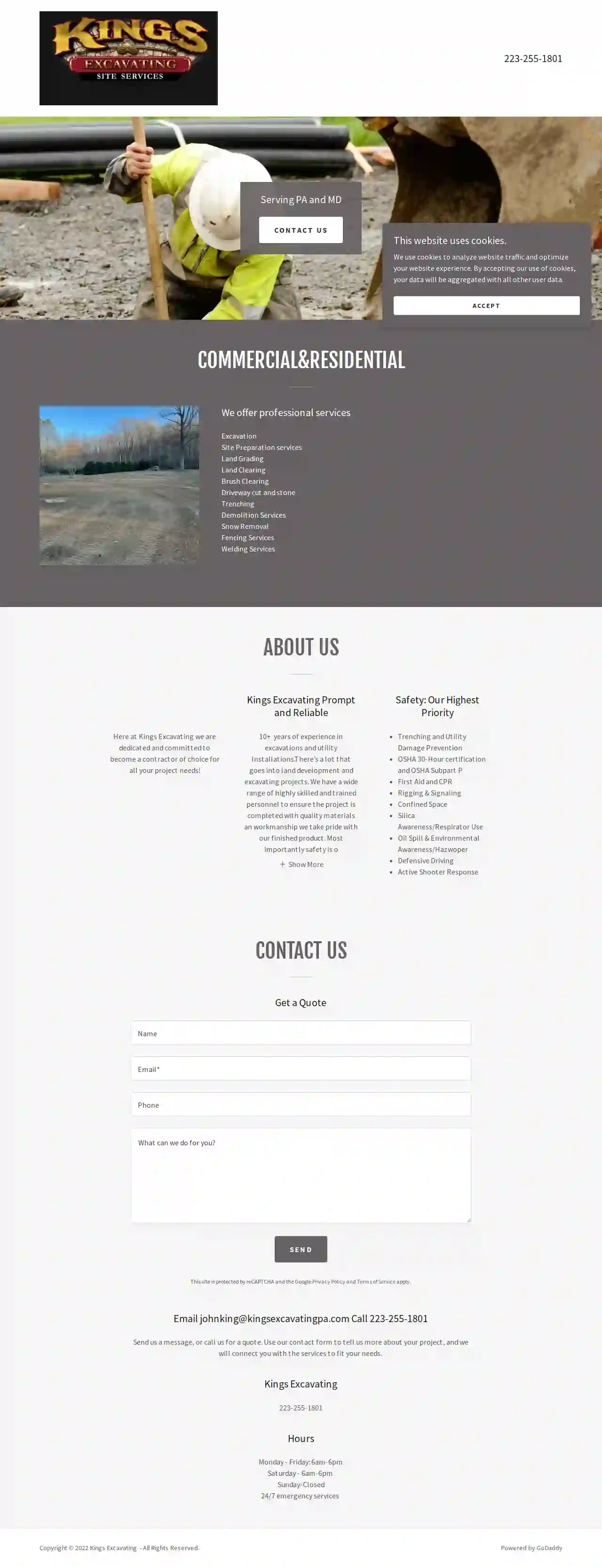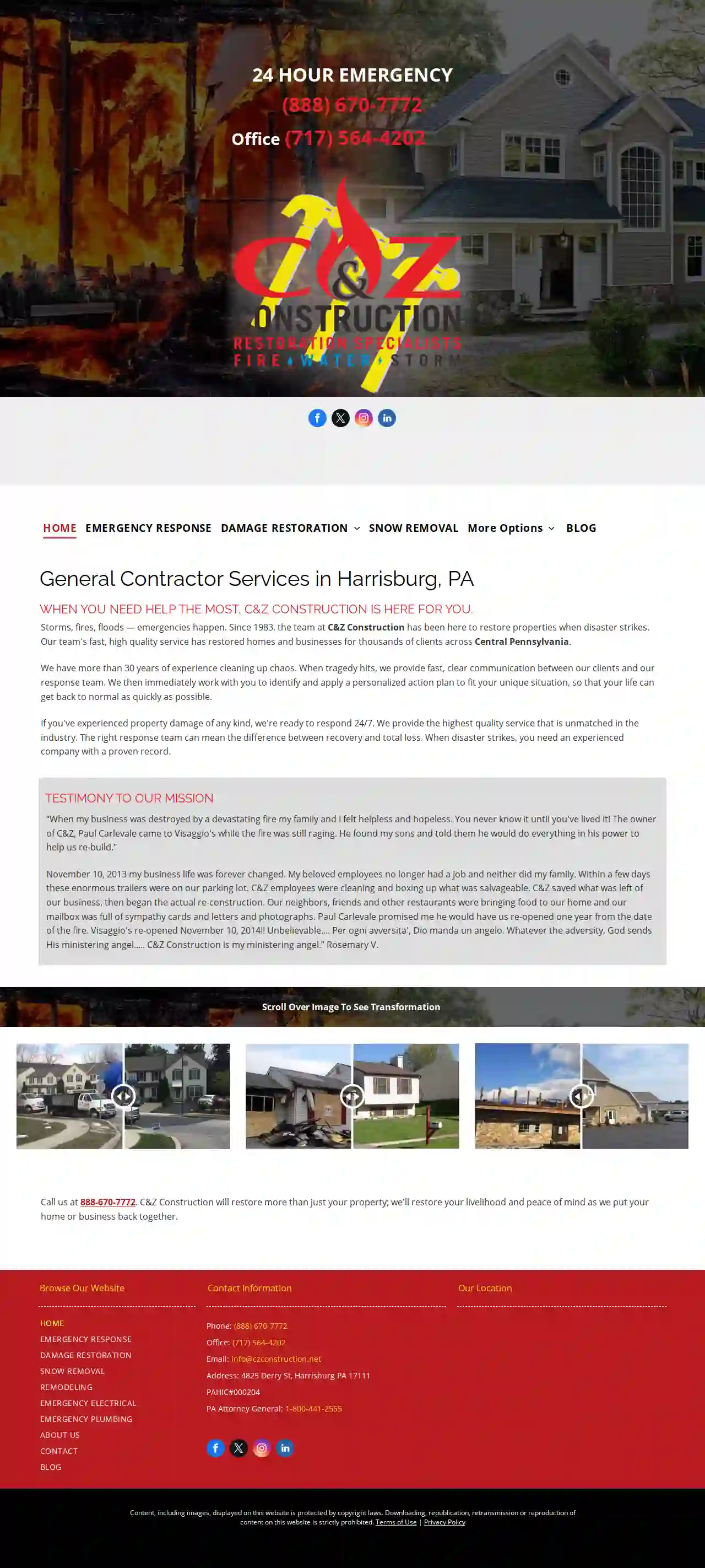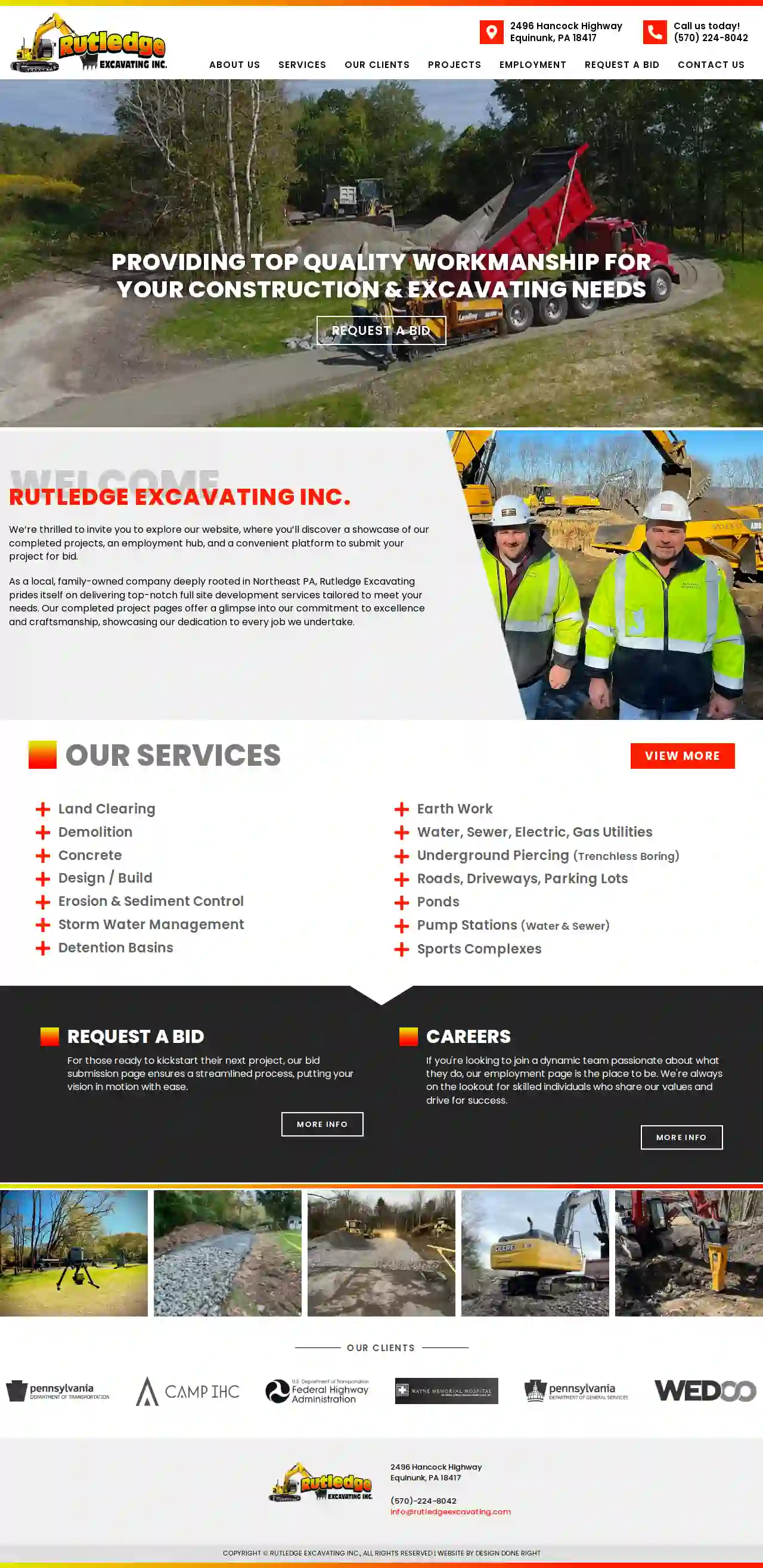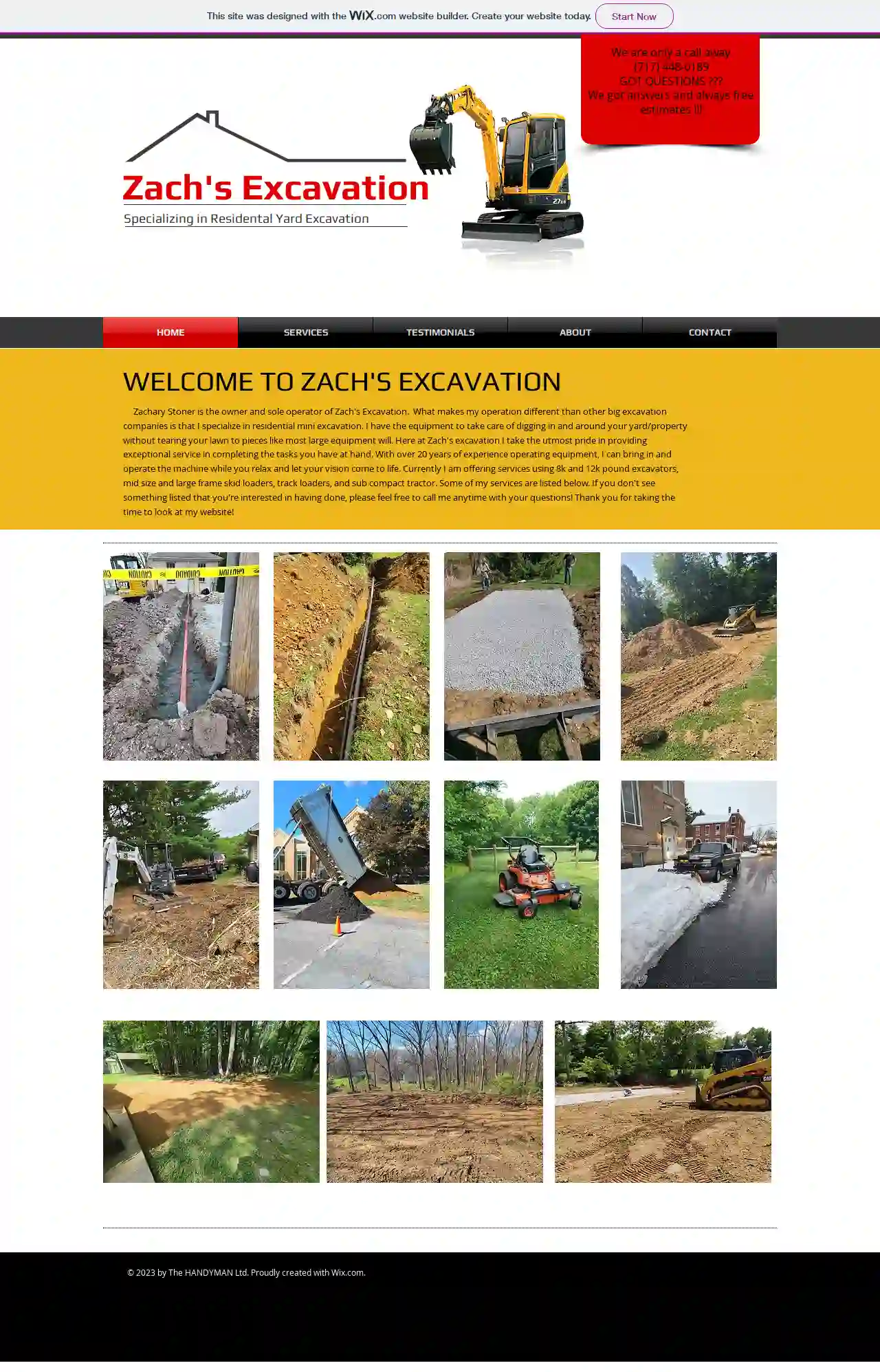Demolition Contractors Collier
Find the best Building Demolition in Collier
Receive up to 3 Demolition Companies quotes for your project today! Compare profiles, reviews, accreditations, portfolio, etc... and choose the best deal.

Kings Excavating
Pittsburgh, USKings Excavating: Prompt and Reliable Here at Kings Excavating, we are dedicated and committed to becoming your contractor of choice for all your project needs! With over 10 years of experience in excavations and utility installations, we have a wide range of highly skilled and trained personnel to ensure your project is completed with quality materials and workmanship. We take pride in our finished product, and most importantly, safety is our number one priority. We strive to create a safe working environment for our employees and the public throughout every project. Safety: Our Highest Priority We prioritize safety in all our operations, adhering to the highest industry standards. Our team is equipped with the necessary certifications and training to ensure a safe and efficient work environment. Our commitment to safety includes: Trenching and Utility Damage Prevention OSHA 30-Hour certification and OSHA Subpart P First Aid and CPR Rigging & Signaling Confined Space Silica Awareness/Respirator Use Oil Spill & Environmental Awareness/Hazwoper Defensive Driving Active Shooter Response
- Services
- Why Us?
- Gallery
Get Quote
Bayside Excavation & Hauling
522 reviewsMillington, USBayside Excavation & Hauling: Your Trusted Partner for Excavation and Hauling Services in Millington, MD Bayside Excavation & Hauling is a leading provider of excavation and hauling services in Millington, MD, serving Caroline, Kent, Queen Anne's, and Talbot counties. With decades of experience and a commitment to excellence, we offer a comprehensive range of services to meet your needs, whether you're a homeowner, contractor, or business owner. Our team of experienced professionals is dedicated to providing personalized service and high-quality results. We understand that every project is unique, and we work closely with our clients to ensure that their needs are met. We are committed to safety, efficiency, and customer satisfaction. What sets us apart? **Decades of Experience:** Our team boasts over 100 years of combined experience, ensuring that every project benefits from seasoned insights, innovative solutions, and unparalleled skill. **Comprehensive Services:** We offer a wide range of services, including excavation, hauling, land clearing, demolition, and septic system installation and repairs, providing a one-stop solution for all your excavation and hauling needs. **Personalized Approach:** We prioritize personalized service tailored to each client's unique needs and project specifications. From initial consultation to project completion, we work closely with clients to understand their objectives, offer expert advice, and deliver results that exceed expectations.
- Services
- Why Us?
- Gallery
Get Quote
Four Bridges Construction & Renovations
131 Main St, Staten Island, 10307, USAbout Four Bridges Construction & Renovations At Four Bridges, we are residential and commercial contractors serving Staten Island and the Tri-State Area. We bring a unique blend of vision and experience, both as building designers and builders, allowing us to offer valuable insight and advice to help you design your dream home, remodel, or addition. We handle site development, planning, zoning, and navigate any hurdles you might encounter in your building project. We stay abreast of the latest construction trends to ensure your project is built with the highest quality and efficiency. Let our years of experienced designing and building work for you.
- Services
- Why Us?
- Gallery
Get Quote
C&Z Construction
4.332 reviews4825 Derry St, Harrisburg PA, Harrisburg, 17111, USWhen you need help the most, C&Z Construction is here for you. Storms, fires, floods — emergencies happen. Since 1983, the team at C&Z Construction has been here to restore properties when disaster strikes. Our team's fast, high quality service has restored homes and businesses for thousands of clients across Central Pennsylvania. We have more than 30 years of experience cleaning up chaos. When tragedy hits, we provide fast, clear communication between our clients and our response team. We then immediately work with you to identify and apply a personalized action plan to fit your unique situation, so that your life can get back to normal as quickly as possible. If you've experienced property damage of any kind, we're ready to respond 24/7. We provide the highest quality service that is unmatched in the industry. The right response team can mean the difference between recovery and total loss. When disaster strikes, you need an experienced company with a proven record. TESTIMONY TO OUR MISSION “When my business was destroyed by a devastating fire my family and I felt helpless and hopeless. You never know it until you've lived it! The owner of C&Z, Paul Carlevale came to Visaggio's while the fire was still raging. He found my sons and told them he would do everything in his power to help us re-build." November 10, 2013 my business life was forever changed. My beloved employees no longer had a job and neither did my family. Within a few days these enormous trailers were on our parking lot. C&Z employees were cleaning and boxing up what was salvageable. C&Z saved what was left of our business, then began the actual re-construction. Our neighbors, friends and other restaurants were bringing food to our home and our mailbox was full of sympathy cards and letters and photographs. Paul Carlevale promised me he would have us re-opened one year from the date of the fire. Visaggio's re-opened November 10, 2014!! Unbelievable.... Per ogni avversita', Dio manda un angelo. Whatever the adversity, God sends His ministering angel..... C&Z Construction is my ministering angel.” Rosemary V.
- Services
- Why Us?
- Testimonials
- Gallery
Get Quote
Rutledge Excavating Inc.
3.56 reviews2496 Hancock Highway, Equinunk, 18417, USWELCOME RUTLEDGE EXCAVATING INC. We’re thrilled to invite you to explore our website, where you’ll discover a showcase of our completed projects, an employment hub, and a convenient platform to submit your project for bid. As a local, family-owned company deeply rooted in Northeast PA, Rutledge Excavating prides itself on delivering top-notch full site development services tailored to meet your needs. Our completed project pages offer a glimpse into our commitment to excellence and craftsmanship, showcasing our dedication to every job we undertake. OUR SERVICES View More Land Clearing Demolition Concrete Design / Build Erosion & Sediment Control Storm Water Management Detention Basins Earth Work Water, Sewer, Electric, Gas Utilities Underground Piercing (Trenchless Boring) Roads, Driveways, Parking Lots Ponds Pump Stations (Water & Sewer) Sports Complexes REQUEST A BID For those ready to kickstart their next project, our bid submission page ensures a streamlined process, putting your vision in motion with ease. MORE INFO CAREERS If you're looking to join a dynamic team passionate about what they do, our employment page is the place to be. We're always on the lookout for skilled individuals who share our values and drive for success. MORE INFO
- Services
- Why Us?
- Gallery
Get Quote
Kirby Kitner Excavating & Paving
4.86 reviews7214 Spring Road, New Bloomfield, USWelcome to Kirby Kitner Excavating! Whether it is site prep for new structures, foundations, road building, graves sites, drainage or septic systems, Kirby consults with all customers personally and is present on all job sites to assure you of quality workmanship. Our staff is professional, experienced, and dependable. We are celebrating our 39th year in business. Kirby Kitner Excavating is a local, family-owned business. Our company is fully insured and we give free estimates. Kirby Kitner Excavating is a DOT Registered Motor Carrier: USDOT 2291670 and a Registered PA Contractor: # PA027056. We are members of the Perry County Chamber of Commerce. Kirby Kitner Excavating is located at 7214 Spring Road, New Bloomfield, PA.
- Services
- Why Us?
- Gallery
Get Quote
Zach's Excavation
56 reviewsHarrisburg, USZach's Excavation Zachary Stoner is the owner and sole operator of Zach's Excavation. What sets my operation apart from larger excavation companies is my specialization in residential mini excavation. I have the equipment to handle digging in and around your yard/property without causing extensive damage to your lawn, unlike most heavy equipment. At Zach's Excavation, I take immense pride in delivering exceptional service and completing your projects to the highest standards. With over 20 years of experience operating equipment, I can bring in and operate the machine while you relax and watch your vision come to life. Currently, I offer services using 8k and 12k pound excavators, mid-size and large frame skid loaders, track loaders, and sub-compact tractors. Some of my services are listed below. If you don't see a service you're interested in, please don't hesitate to call me anytime with your questions! Thank you for taking the time to visit my website!
- Services
- Why Us?
- Gallery
Get Quote
Tribar Services Inc
54 reviews950 Route 36, Suite 101, Leonardo, 07737, USAbout Tribar Services Family owned and operated since 1995, we pride ourselves on maintaining deep ties to our community, while delivering a lasting and sustainable (literal) foundation for our clients. Based in Monmouth County and operating throughout the Mid-Atlantic, including Connecticut, we offer a wide range of services, performed by a staff of highly qualified and seasoned professionals. Such services include all aspects of Demolition, Foundation Repair & Construction, Full Service House Lifting, House Elevation, & House Raising, along with Concrete Masonry, Flatwork, & Hardscaping and including Rigging, Heavy Lifting, and Emergency Salvage related services. Our Core Values: We are a full service demolition company bringing the highest quality workmanship using the most cost effective means. Uniqueness: We tackle difficult projects with innovative solutions and creative strategies looking at each project with the philosophy of reduce, reuse and recycle. Service: Our staff of professionals are seasoned with diverse qualifications and backgrounds and the ability to give our clients the personal attention only a small company can provide. Including a full time NYC permit expediter. Integrity: A practice we apply to every project and expect from every employee to achieve the highest standards of professionalism and safety. We are fully licensed by the state of NJ, our license number is 13HE00003400. For information on your Demolition, House Raising, Boat Salvage & Recovery, Foundation Repair or Rigging project, contact the experts at Tribar Services, Inc. Contact us through our website by clicking here, or call us at 732-291-3464.
- Services
- Why Us?
- Our Team
- Testimonials
- Gallery
Get Quote
Ironstone Excavating
4.58 reviews2551 Mill Road, Elizabethtown, 17022, USIronstone Excavating: Your Premier Excavation Company Ironstone Excavating is your one-stop excavating service company, proudly serving Lancaster, Dauphin, York, Lebanon Counties, and beyond. We understand the importance of a strong foundation for any structure, and we're committed to providing the highest quality excavation services to ensure your project is built to last. We offer a wide range of services, including: Excavation for residential, commercial, and agricultural projects Utility line installation and replacement Demolition services for fire damage and other property issues Septic system installation and maintenance Our team of experienced professionals is dedicated to providing exceptional service and ensuring your satisfaction. We use the latest equipment and techniques to complete your project on time and within budget. Contact us today for a free estimate and let us help you build a solid foundation for your future.
- Services
- Why Us?
- Testimonials
- Gallery
Get Quote
Central Penn. Excavating llc
51 reviewsHarrisburg, USYour Trusted Partner in Excavation and Site Preparation At Central Penn Excavating, we specialize in delivering top-quality excavation, land clearing, tree removal, hardscaping, and concrete services across Pennsylvania. Whether you're preparing a site for construction, enhancing your landscape, or removing hazardous trees, our experienced team is here to ensure your project is completed with precision, safety, and excellence. Let us lay the groundwork for your success with reliable, professional service you can count on. Our Story: Building Strong Foundations for Pennsylvania Central Penn Excavating was founded with a commitment to delivering exceptional service and quality in every project we undertake. As a locally owned and operated company, we pride ourselves on our deep roots in the Pennsylvania community and our dedication to helping our neighbors achieve their goals. From humble beginnings, we have grown into a trusted name in excavation, land clearing, and site preparation, known for our reliability, professionalism, and attention to detail.
- Services
- Why Us?
- Gallery
Get Quote
Over 22,076+ Excavation Contractors in our network
Our excavation companies operate in Collier & beyond!
ExcavationHQ has curated and vetted the Best Excavation Contractors in Collier. Find a trustworthy business today.
Frequently Asked Questions About Demolition Contractors
- Recycling: Concrete, brick, metal, and wood can be recycled and reused in other construction projects, reducing waste sent to landfills.
- Landfill Disposal: Non-recyclable materials are disposed of in designated landfills according to local regulations.
- Donation: Some materials, such as fixtures or appliances, may be suitable for donation to charitable organizations.
- Permits and Regulations: Obtain all necessary demolition permits and comply with local building codes and environmental regulations.
- Contracts: Have a clear and comprehensive contract with the demolition contractor outlining the scope of work, payment terms, and liabilities.
- Environmental Laws: Comply with environmental laws regarding hazardous material removal, waste disposal, and pollution control.
- Neighboring Property Rights: Respect neighboring property rights and take measures to prevent damage or disruption to adjacent properties.
- Worker Safety: Adhere to worker safety regulations and provide a safe working environment for demolition crews.
- Size and Type of Structure: The method should be suitable for the structure's size, height, and construction materials.
- Site Location and Accessibility: The method should be feasible given the site's location, surrounding buildings, and access constraints.
- Environmental Considerations: Prioritize methods that minimize environmental impact, such as deconstruction or selective demolition if feasible.
- Budget: Different demolition methods have varying costs, so choose one that fits your budget.
- Safety: Prioritize methods that ensure worker safety and minimize risks to surrounding areas.
- Site Security: Secure the demolition site with fencing and warning signs to prevent unauthorized access.
- Personal Protective Equipment (PPE): Workers should wear appropriate PPE, including hard hats, safety glasses, gloves, and steel-toe boots.
- Hazardous Material Removal: Properly identify and remove asbestos, lead paint, or other hazardous materials before demolition begins.
- Utility Disconnections: Disconnect all utilities, such as electricity, gas, and water, before demolition.
- Controlled Demolition Techniques: Employ controlled demolition methods to minimize risks and ensure the structure comes down safely.
- Dust Control: Implement dust suppression measures, such as water spraying or misting, to reduce airborne particles and protect air quality.
- Emergency Planning: Have an emergency plan in place, including communication protocols and evacuation procedures, in case of unforeseen events.
What happens to the debris after demolition?
What are the legal considerations for demolition projects?
How do I choose the right demolition method for my project?
What are the safety precautions for demolition?
What happens to the debris after demolition?
- Recycling: Concrete, brick, metal, and wood can be recycled and reused in other construction projects, reducing waste sent to landfills.
- Landfill Disposal: Non-recyclable materials are disposed of in designated landfills according to local regulations.
- Donation: Some materials, such as fixtures or appliances, may be suitable for donation to charitable organizations.
What are the legal considerations for demolition projects?
- Permits and Regulations: Obtain all necessary demolition permits and comply with local building codes and environmental regulations.
- Contracts: Have a clear and comprehensive contract with the demolition contractor outlining the scope of work, payment terms, and liabilities.
- Environmental Laws: Comply with environmental laws regarding hazardous material removal, waste disposal, and pollution control.
- Neighboring Property Rights: Respect neighboring property rights and take measures to prevent damage or disruption to adjacent properties.
- Worker Safety: Adhere to worker safety regulations and provide a safe working environment for demolition crews.
How do I choose the right demolition method for my project?
- Size and Type of Structure: The method should be suitable for the structure's size, height, and construction materials.
- Site Location and Accessibility: The method should be feasible given the site's location, surrounding buildings, and access constraints.
- Environmental Considerations: Prioritize methods that minimize environmental impact, such as deconstruction or selective demolition if feasible.
- Budget: Different demolition methods have varying costs, so choose one that fits your budget.
- Safety: Prioritize methods that ensure worker safety and minimize risks to surrounding areas.
What are the safety precautions for demolition?
- Site Security: Secure the demolition site with fencing and warning signs to prevent unauthorized access.
- Personal Protective Equipment (PPE): Workers should wear appropriate PPE, including hard hats, safety glasses, gloves, and steel-toe boots.
- Hazardous Material Removal: Properly identify and remove asbestos, lead paint, or other hazardous materials before demolition begins.
- Utility Disconnections: Disconnect all utilities, such as electricity, gas, and water, before demolition.
- Controlled Demolition Techniques: Employ controlled demolition methods to minimize risks and ensure the structure comes down safely.
- Dust Control: Implement dust suppression measures, such as water spraying or misting, to reduce airborne particles and protect air quality.
- Emergency Planning: Have an emergency plan in place, including communication protocols and evacuation procedures, in case of unforeseen events.